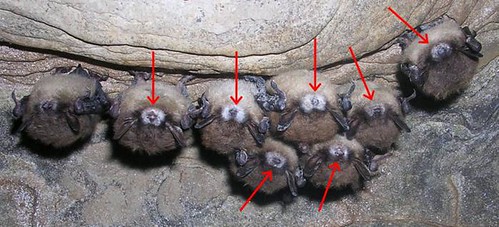
Link-->Northeastern Bats Dying By The Thousands

Hibernating bats suffering from the mysterious "White Nose Syndrome" (arrows).
If you live in New York or Vermont, then you might have heard about the mystery disease that is killing tens of thousands of bats hibernating in caves and mines throughout these two states. The disease has been given the descriptive appellation, "white nose syndrome" because its most obvious symptom (besides death), is the peculiar ring of white fungus that forms on the bats' muzzles.
Last January, this mystery disease killed between 8,000 and 11,000 bats that were hibernating in four caves (Hailes and Knox Caves, Schoharie and Gages Caverns) located just west of Albany, NY. Data from Hailes Cave and Schoharie Cavern, the sites with the most reliable data so far, lost over half their populations last winter alone. This disease is devastating when it strikes; for example, one cave went from a population of more than 15,000 bats two years ago to only 1,500 today.
Unfortunately, the mystery disease continues to ravage hibernating bats. For example, the bat population in Cobleskill cave numbered around 1,300 in 2006 but declined to 470 in 2007.
"This year there's 38 bats there. Half of them are dying [from the white-nose syndrome]," said Alan Hicks, a bat specialist with New York's Department of Environmental Conservation.
"The bats haven't started dying yet in large numbers this year, but they're following exactly the same trends they followed last year where a very large percentage of them died," according to Hicks.
One of the caves near Albany is home to about 100,000 bats during hibernation; another houses about 50,000.
"We're talking a lot of bats that are in immediate danger."
Worse, survey data for 2008 reveals that the disease has spread to yet more bat hibernacula located within a 110-mile radius of Albany; eight in Schoharie County, NY, and another one in Vermont.
Even though this disease does not appear to affect humans, there is concern that cavers who have been in infected caves might carry the infection on their clothing, boots or equipment to uncontaminated caves that they subsequently visit. Thus, the New York State Department of Environmental Conservation (DEC) is asking cavers to carefully decontaminate their clothing and equipment to prevent this disease from possibly spreading across the entire North American continent.
"We do not know what the cause is and we do not know how it was spread, either from cave to cave, or bat to bat," said a very concerned Hicks, who noted that this rapidly-spreading disease poses the "gravest threat" to wild bats that he has ever seen. "[Thus] You have this potential for this huge spread."
The white fungus has been identified as a common genus of fungi, Fusarium sp., that is typically associated with plants. But oddly, the fungus may not necessarily be the cause of the bats' untimely demise. In fact, according to pathologists' reports, the dead bats mysteriously depleted their fat reserves months early, so they cannot possibly survive their winter hibernation.
Unfortunately, neither the geographic origin nor the species of this fungus have yet been identified. Additionally, none of the major bat researchers in North America have ever seen white nose before, even though it is very obvious in the field and thus, difficult to miss. It seems reasonable to assume that the problem is a new one.
"We are working with DEC pathology and DOH to identify the species, and origin of the fungus, to clearly identify the causes of the bat mortalities, and to develop a course of action to make sure that the problem does not spread. We are open to any and all ideas. We will be revisiting last years mortalities sites beginning early next week and will probably have an abundance of samples at that time for any type of suggested analysis."
So far, this disease is killing four species of bats; Indiana bats, eastern pipistrelle, northern long-eared and little brown bats. This disease is especially devastating because bats produce only one pup per year.
Bats hibernate roughly between November and April. They huddle close together in groups numbering into the thousands, making them especially vulnerable to contageous diseases. So far, the highest mortality has been seen in little brown bats, although there is great concern for the federally endangered Indiana bats, due to their small population size. In fact, a 2007 survey revealed no evidence of Indiana bats in Hailes Cave -- a loss of roughly 700 animals.
Bats perform valuable servies for people and other wildlife. For example, one little brown bat can eat approximately 1,000 mosquitoes in an hour, and they also eat cucumber beetles and other agricultural pests. Mosquitoes carry West Nile Virus and also the new Dengue-type fevers that have been recently discovered. Additionally, bats are also relied upon as indicator species for contaminants that affect mammals.
"I'm very concerned," Hicks said. "I can only hope that what we're seeing today will dissipate in the future."
People who have either observed large numbers of dead or dying bats, have seen bats suffering from "white nose syndrome", or who might have suggestions as to how to identify this pathogen are encouraged to contact Alan Hicks;
Alan Hicks
Mammal Specialist
Endangered Species Unit
NYS Department of Environmental Conservation
625 Broadway, 5th floor
Albany, NY 12233-4754
(518)-402-8854 Cell (518)-461-4632
The Elites don't fear the tall nails, government possesses both the will and the means to crush those folks. What the Elites do fear (or should fear) are the quiet men and women, with low profiles, hard hearts, long memories, and detailed target folders for action as they choose.
"I here repeat, & would willingly proclaim, my unmitigated hatred to Yankee rule—to all political, social and business connections with Yankees, & to the perfidious, malignant, & vile Yankee race."





 Reply With Quote
Reply With Quote


Bookmarks